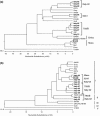Phylogenetic analysis of partial S1 and N gene sequences of infectious bronchitis virus isolates from Italy revealed genetic diversity and recombination
- PMID: 17043759
- PMCID: PMC7088928
- DOI: 10.1007/s11262-006-0037-0
Phylogenetic analysis of partial S1 and N gene sequences of infectious bronchitis virus isolates from Italy revealed genetic diversity and recombination
Abstract
A total of ten infectious bronchitis virus (IBV) isolates collected from commercial chickens in Italy in 1999 were characterized by RT-PCR and sequencing of the S1 and N genes. Phylogenetic analysis based on partial S1 gene sequences showed that five field viruses clustered together with 793/B-type strains, having 91.3-98.5% nucleotide identity within the group, and one isolate had very close sequence relationship (94.6% identity) with 624/I strain. These two IBV types have been identified in Italy previously. The other three variant isolates formed novel genotype detected recently in many countries of Western Europe. For one of these variant viruses, Italy-02, which afterwards became the prototype strain, the entire S1 gene was sequenced to confirm its originality. In contrast, phylogenetic analysis of more conserved partial N gene sequences, comprising 1-300 nucleotides, revealed different clustering. Thus, three variant IBVs of novel Italy-02 genotype, which had 96.7-99.2% S1 gene nucleotide identity with each other, belonged to three separate subgroups based on N gene sequences. 624/I-type isolate Italy-06 together with Italy-03, which was undetectable using S1 gene primers, shared 97.7% and 99.3% identity, respectively, in N gene region with vaccine strain H120. Only one of the 793/B-type isolates, Italy-10, clustered with the 793/B strain sharing 99.3% partial N gene identity, whereas the other four isolates were genetically distant from them (only 87.7-89.7% identity) and formed separate homogenous subgroup. The results demonstrated that both mutations and recombination events could contribute to the genetic diversity of the Italian isolates.
Figures


Similar articles
-
[Genetic variation of S1 gene hypervariable region I of infectious bronchitis viruses isolated in different periods in Guangxi].Bing Du Xue Bao. 2008 Jun;24(2):126-32. Bing Du Xue Bao. 2008. PMID: 18533344 Chinese.
-
Sequencing, phylogenetic analysis, and potential recombination events of infectious bronchitis viruses isolated in Korea.Virus Genes. 2013 Apr;46(2):371-4. doi: 10.1007/s11262-012-0856-0. Epub 2012 Dec 1. Virus Genes. 2013. PMID: 23203570
-
Isolation of a variant infectious bronchitis virus in Australia that further illustrates diversity among emerging strains.Arch Virol. 2006 Aug;151(8):1567-85. doi: 10.1007/s00705-006-0726-y. Epub 2006 Feb 23. Arch Virol. 2006. PMID: 16501892 Free PMC article.
-
Phylogenetic analysis of S1 gene of infectious bronchitis virus isolates from China.Avian Dis. 2011 Sep;55(3):451-8. doi: 10.1637/9446-070510-ResNote.1. Avian Dis. 2011. PMID: 22017046
-
S1 glycoprotein gene analysis of infectious bronchitis viruses isolated in Korea.Arch Virol. 2004 Mar;149(3):481-94. doi: 10.1007/s00705-003-0225-3. Epub 2003 Nov 13. Arch Virol. 2004. PMID: 14991438 Free PMC article.
Cited by
-
Coexistence of different genotypes in the same bat and serological characterization of Rousettus bat coronavirus HKU9 belonging to a novel Betacoronavirus subgroup.J Virol. 2010 Nov;84(21):11385-94. doi: 10.1128/JVI.01121-10. Epub 2010 Aug 11. J Virol. 2010. Retraction in: J Virol. 2022 Nov 23;96(22):e0148522. doi: 10.1128/jvi.01485-22. PMID: 20702646 Free PMC article. Retracted.
-
Emergence of a genotype I variant of avian infectious bronchitis virus from Northern part of India.Acta Trop. 2018 Jul;183:57-60. doi: 10.1016/j.actatropica.2018.04.004. Epub 2018 Apr 3. Acta Trop. 2018. PMID: 29621536 Free PMC article.
-
Infectious bronchitis viruses with naturally occurring genomic rearrangement and gene deletion.Arch Virol. 2011 Feb;156(2):245-52. doi: 10.1007/s00705-010-0850-6. Epub 2010 Nov 4. Arch Virol. 2011. PMID: 21049275 Free PMC article.
-
A recombinant avian infectious bronchitis virus expressing a heterologous spike gene belonging to the 4/91 serotype.PLoS One. 2011;6(8):e24352. doi: 10.1371/journal.pone.0024352. Epub 2011 Aug 30. PLoS One. 2011. PMID: 21912629 Free PMC article.
-
GI-16 lineage (624/I or Q1), there and back again: The history of one of the major threats for poultry farming of our era.PLoS One. 2018 Dec 20;13(12):e0203513. doi: 10.1371/journal.pone.0203513. eCollection 2018. PLoS One. 2018. PMID: 30571679 Free PMC article.
References
MeSH terms
Substances
Associated data
- Actions
- Actions
- Actions
- Actions
- Actions
- Actions
- Actions
- Actions
- Actions
- Actions
- Actions
- Actions
- Actions
- Actions
- Actions
- Actions
- Actions
- Actions
- Actions
LinkOut - more resources
Full Text Sources
Other Literature Sources

